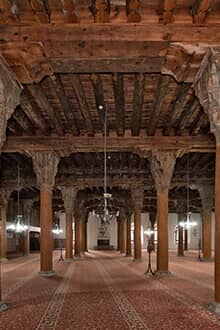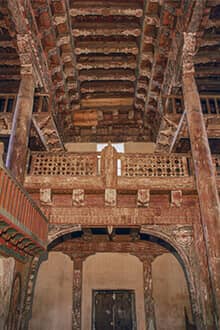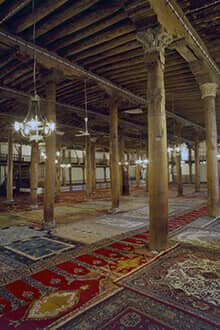

Authentic Wooden Mosques
Eskişehir – Ankara – Kastamonu – Konya – Samsun – Afyon
The Seljuk and Ottoman wooden mosques of Anatolia are rare examples of religious architecture with nailess use of wood and impressive handcrafted decoration. Wooden roofed and wooden columned mosques concentrate in Konya, Ankara and Kastamonu from Anatolian Seljuks period and Beyliks period. Building tradition of wooden roofed and wooden columned mosques continued until the beginning of 20th century in the remote regions from the center in the Ottoman period. Wooden Roofed and Wooden Columned Mosques in Anatolia are included in the the UNESCO World Heritage List.
Sivrihisar Ulu Cami (Grand Mosque) is located in Eskişehir and is included on the UNESCO World Heritage List. It is the largest of the rare wooden pillar mosques of Anatolia and has survived from the Seljuk period.
The eight-century old Sivrihisar Ulu Mosque, where 2,500 people can worship at the same time, is one of the rare examples of the large wooden-columned mosques in Anatolia. In the center of the district, the word “ulu” (grand) finds its full meaning in this work.
Afyonkarahisar Ulu Cami (Grand Mosque) is one of the largest mosques of Afyonkarahisar and was built in the Anatolian Seljuk period between 1272 and 1277. The mosque, which was reconstructed by preserving its old form, is one of the unique examples of the Seljuk period with its wooden and brick architecture with glazed tiles. A wooden beam roof that stretches across nine naves is supported by 40 wooden columns whose capitals are adorned with stalactine decorations.
Göğceli Mosque in Samsun is considered Türkiye’s oldest surviving wooden mosque. It is one of the most significant samples of Turkish wooden architecture. It was constructed using a technique of interlacing wooden beams without using nails. There is no record of the date of construction; however, according to radiocarbon tests the mosque was built in 1206 and the porch in 1335. In 2007, the mosque underwent a comprehensive restoration.
Bekdemir Mosque is located in the village of Kavak, Samsun. Although there is no inscription regarding its construction date, the date on a historical embroidery (1877) is accepted as the date it was built. According to a survey, the main floor was built in 1596. The mosque is another example of a “nailess” wooden construction. It is adorned with various floral motifs colored with natural dyes, and there is a stonework fountain in the courtyard.
Mahmutbey Mosque is located in the village of Kasaba in Kastamonu, 18 kilometers northwest of the city. It is the only work in Kastamonu that is on the UNESCO World Heritage Temporary List. It was built as the Friday Mosque in 1366 by Emir Mahmut Bey, the ruler of the Candaroğulları Principality. The exterior walls of the mosque are made of hewn stone. The roof is made exclusively of wood with no metal elements and plaster was only used in the mihrab. One of the most eye-catching and important elements of the mosque is the door built by Abdullah, son of Nakkaş Mahmut from Ankara.
Eşrefoğlu Mosque in Beyşehir, Konya is the largest and one of the most original of the wooden-columned mosques in Anatolia and was built between 1296 and 1299. The mosque is one of the most beautiful examples of the Turkish wooden architectural tradition. The monumental white marbel gate, and the unique mihrab and minbar (pulpit) display superior quality wood and tile craftmanship. The mihrab is covered with glazed tiles and is 4.58 meters wide and 6.17 meters high - larger than all the tiled mihrabs around Konya. The minbar is carved entirely out of walnut wood with a superior workmanship and rich ornamentation. It is covered in octagonal, pentagonal, star, and geometric shapes and vegetable embellishments. The ceiling of the mosque is decorated in vivid ornaments using the “kalem isi” (hand-drawn) technique. Eşrefoğlu Mosque is a unique structure that contains all the features seen across numerous Seljuk mosques: multiple wooden columns, a ceiling completely decorated with wood and “kalem isi” work, a minbar made completely out of wood, and the kündekari technique (using interlocking pieces of wood with no nails or glue). The mosque, which reflects the magnificence of stone and wood workmanship of the period, was included in the UNESCO World Heritage Temporary List in 2012.
Aslanhane Mosque: Aslanhane Mosque, located in the district of Samanpazarı in Ankara, despite its very plain appearance from the outside, is an important work with a history of eight centuries long. Built by the architect Ebubekir Mehmet, this mosque with rare wood work is also known as Ahi Şerafettin Mosque. It was named Aslanhane Mosque because of the ancient lion statue buried in the wall of the tomb complex. The single-storey mosque stands on 24 wooden legs. The column heads of each of these pillars, made of walnut wood, are made of spolia marble Roman-Byzantine materials. With its architectural features and ornaments this Seljukian mosque will fascinate visitors with its architectural features and ornaments from the moment you stepped into it




